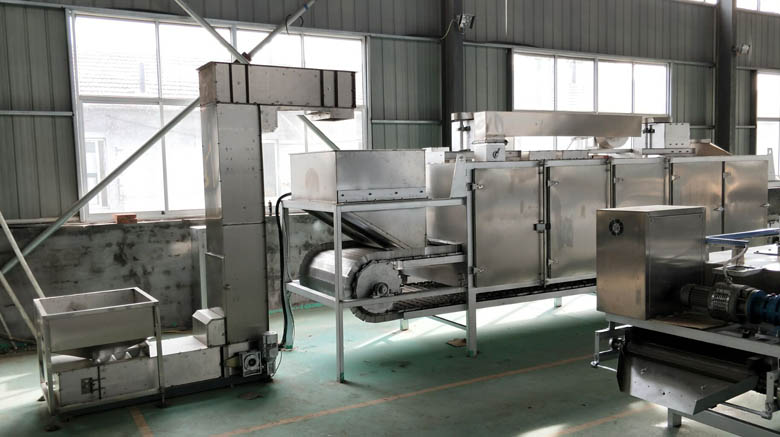Function of the heat converter of peanut roaster line
Peanut roasting is an essential process in nut processing. The peanut roaster production line is composed of heat converter, air supply device, roasting box and other parts. It is a professional production equipment for roasting nuts, and is mainly used for roasting or drying peanuts, chestnuts, walnuts, almonds, broad beans, soybeans, coffee beans, melon seeds and other granular nut foods. Peanut roasting machine is divided into coal heating, gas heating, electric heating and other heating forms. It adopts the principles of rotary roller cage, heat conduction and heat radiation. During roasting, materials are continuously pushed by spiral blades in the roller to form uninterrupted rolling, which makes it evenly heated, effectively ensuring roasting quality, with low production cost and high efficiency. Peanuts roasted in a peanut roasting machine are clean, hygienic, crisp and delicious.

Heat converter is one of the key components of peanut roaster line. The function of heat exchanger of peanut roaster production line is that high-temperature steam transfers heat to cold air through steam heat exchanger, which makes the cold air quickly heat up and dry. After primary filtering, the fan exchanges heat with the radiator and sends it to the air chamber, and then it is purified by secondary filtering. The hot air passes through the internal circulation of the air door, and most of the hot air is continuously heated and utilized except a small amount of fresh air. Its heat medium is steam, which diffuses heat through finned tubes, convection and forced radiation, thus achieving the effect of over-drying. The heat converter of a peanut roasting line is a component that plays a critical role in the roasting process. The converter is responsible for converting the heat energy produced by a fuel source into heat that can be used to roast the peanuts.
The heat converter typically consists of a combustion chamber, a heat exchanger, and a blower. The combustion chamber is where the fuel is burned to produce heat. The heat exchanger transfers the heat from the combustion chamber to the air that is used to roast the peanuts. The blower circulates the hot air through the roasting chamber to evenly roast the peanuts.
There are several types of heat converters that can be used in peanut roasting lines.
Some of the most common types include:
Gas-fired heat converter – uses natural gas or propane to generate heat.
Electric heat converter – uses electricity to generate heat.
Biomass heat converter – uses wood, agricultural waste, or other organic materials to generate heat.
Diesel-fired heat converter – uses diesel fuel to generate heat.
The choice of heat converter depends on several factors such as the availability and cost of fuel, the desired level of automation, and the environmental impact of the fuel source. Regardless of the type of heat converter used, it is important to maintain proper airflow and temperature control to ensure the peanuts are roasted evenly and to prevent burning.
This kind of equipment, which is widely used in industry at present, has the function of environmental protection and high efficiency, and can bring ideal economic benefits to enterprises.
Our company produces and sells a variety of peanut roasting machine, among which the drum rotary peanut roasting machine and continuous automatic peanut roasting machine are the most popular among customers. When choosing to buy a peanut roasting machine, you should choose according to your actual production needs. As the key equipment of peanut product processing, peanut roasting machine plays an indispensable role in peanut product processing.
